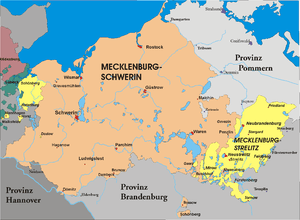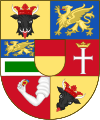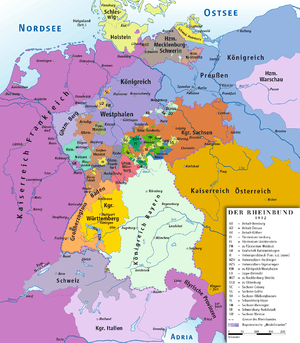Duchy of Mecklenburg-Strelitz
| Duchy of Mecklenburg-Strelitz | ||||||||||
| Herzogtum Mecklenburg-Strelitz | ||||||||||
| State of the Holy Roman Empire (until 1806) | ||||||||||
| ||||||||||
| ||||||||||
 Mecklenburg-Strelitz | ||||||||||
| Capital | Strelitz then Neustrelitz | |||||||||
| Government | Feudal monarchy | |||||||||
| Duke of Mecklenburg-Strelitz | ||||||||||
| • | 1701–1708 | Adolphus Frederick II | ||||||||
| • | 1708–1752 | Adolphus Frederick III | ||||||||
| • | 1752–1794 | Adolphus Frederick IV | ||||||||
| • | 1794–1815 | Charles II | ||||||||
| History | ||||||||||
| • | Treaty of Hamburg | 1701 | ||||||||
| • | Raised to Grand Duchy | 1815 | ||||||||
| ||||||||||
| Today part of | | |||||||||
| Wikimedia Commons has media related to Duchy of Mecklenburg-Strelitz. |
The Duchy of Mecklenburg-Strelitz was a duchy in northern Germany, consisting of the eastern fifth of the historic Mecklenburg region, roughly corresponding with the present-day Mecklenburg-Strelitz district (the former Lordship of Stargard), and the western exclave of the former bishopric of Ratzeburg in modern Schleswig-Holstein. At the time of its establishment, the duchy bordered on the territory of Swedish Pomerania in the north and of Brandenburg in the south.
History
After more than five years of dispute over succession to the House of Mecklenburg, the duchy was established in 1701 in the territory of the former duchy of Mecklenburg-Güstrow. The Güstrow branch of the House of Mecklenburg had died out with the death of Duke Gustav Adolph in 1695. Duke Frederick William of Mecklenburg-Schwerin claimed heirship, but he had to deal with the demands of his uncle Adolphus Frederick, husband of Mary of Mecklenburg-Güstrow, the daughter of Gustav Adolph. The emissaries of the Lower Saxon Circle finally negotiated a compromise on March 8, 1701. The agreement created the final, definitive division of Mecklenburg and was sealed with the 1701 Treaty of Hamburg. Section 2 of the treaty established Mecklenburg-Strelitz as a duchy in its own right and assigned it to Adolphus Frederick, together with the Principality of Ratzeburg on the western border of Mecklenburg south of Lübeck, the Herrschaft Stargard in the southeast of Mecklenburg, with the cities of Neubrandenburg, Friedland, Woldegk, Strelitz, Burg Stargard, Fürstenberg/Havel and Wesenberg, and the commandries of Mirow and Nemerow. At the same time the principle of primogeniture was reasserted, and the right to summon the joint Landtag was reserved to the Duke of Mecklenburg-Schwerin. The 1701 provisions were maintained with minor changes until the end of the monarchy. Both parties continued to call themselves Dukes of Mecklenburg; Adolphus Frederick took his residence at Strelitz.
The Strelitz duchy remained one of the most backward regions of the Empire. Nevertheless, its princesses achieved prominent marriages: Charlotte of Mecklenburg-Strelitz, sister of Duke Adolphus Frederick IV, married King George III in 1761, thus becoming queen consort of Great Britain. Her niece Louise of Mecklenburg-Strelitz, daughter of Duke Charles II, Grand Duke of Mecklenburg, married Frederick William III of Hohenzollern in 1793 and became queen consort of Prussia in 1797.
Mecklenburg-Strelitz adopted the constitution of the sister duchy in September 1755. In 1806 was spared the infliction of a French occupation through the good offices of the king of Bavaria.[1] In 1808 its duke, Charles (d. 1816), joined the Confederation of the Rhine, but in 1813 he withdrew from it. The Congress of Vienna recognized both Mecklenburg-Strelitz and Mecklenburg-Schwerin as grand duchies and members of the German Confederation.
References
- ↑ Chisholm 1911, p. 1020.
![]() This article incorporates text from a publication now in the public domain: Chisholm, Hugh, ed. (1911). "Mecklenburg". Encyclopædia Britannica. 17 (11th ed.). Cambridge University Press. pp. 1018–20.
This article incorporates text from a publication now in the public domain: Chisholm, Hugh, ed. (1911). "Mecklenburg". Encyclopædia Britannica. 17 (11th ed.). Cambridge University Press. pp. 1018–20.




